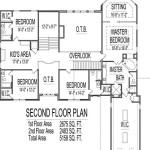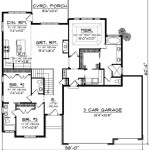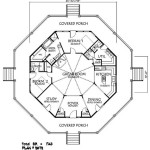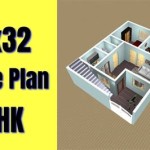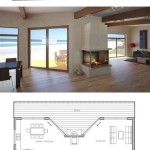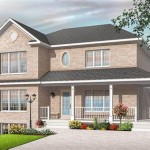A tiny house loft floor plan is a design that incorporates a sleeping or living space on a raised platform within a tiny house, typically accessed by a ladder or stairs. These plans maximize vertical space, providing additional room for essential amenities without significantly increasing the overall footprint of the house.
For instance, a loft floor plan could include a sleeping area elevated above a compact kitchen and living space. This configuration allows homeowners to utilize the ground level for necessary appliances and daily activities while dedicating the upper loft area solely for rest and relaxation.
In the following sections, we will explore different tiny house loft floor plans, their advantages and drawbacks, and practical tips for designing and constructing such spaces.
Tiny house loft floor plans offer a range of benefits, including space optimization, flexibility, and cost-effectiveness. However, it’s crucial to consider potential drawbacks such as limited headroom, accessibility challenges, and potential noise issues.
- Maximize vertical space
- Create additional room
- Provide sleeping or living areas
- Utilize ground level for essential amenities
- Increase storage capacity
- Limited headroom
- Accessibility challenges
- Potential noise issues
- Design considerations
- Construction requirements
Careful planning and design can mitigate these drawbacks and create functional and comfortable tiny house loft spaces.
Maximize vertical space
Tiny house loft floor plans are designed to make the most of vertical space, allowing homeowners to create additional living areas without increasing the overall footprint of their home. This is especially important in tiny houses, where every square foot counts.
One way to maximize vertical space is to use a raised sleeping loft. This creates a separate sleeping area that is elevated above the main living space. The loft can be accessed by a ladder or stairs, and it can be used for sleeping, storage, or even as a home office.
Another way to maximize vertical space is to use built-in furniture. For example, a sofa can be built into the wall, and a bed can be built into a platform. This type of furniture takes up less space than freestanding furniture, and it can help to create a more cohesive and organized look.
Finally, tiny house loft floor plans often incorporate clever storage solutions. For example, there may be built-in shelves and drawers under the stairs, or there may be a storage loft above the kitchen cabinets. These storage solutions help to keep the tiny house organized and clutter-free.
By maximizing vertical space, tiny house loft floor plans can create additional living areas without increasing the overall footprint of the home. This makes them a great option for homeowners who want to live in a small space without sacrificing comfort or functionality.
Create additional room
Tiny house loft floor plans can be used to create additional room in a variety of ways. One common approach is to use a raised sleeping loft, which creates a separate sleeping area that is elevated above the main living space. This frees up valuable floor space that can be used for other purposes, such as a home office, a guest room, or a storage area.
- Separate sleeping area
A raised sleeping loft can be used to create a separate sleeping area that is private and secluded from the rest of the house. This can be especially beneficial in tiny houses, where every square foot of space is important. A sleeping loft can also help to create a more spacious and open feel in the main living area.
- Home office
A loft can also be used to create a home office. This is a great option for people who work from home or who need a dedicated space to work on projects. A home office loft can be equipped with a desk, chair, and other necessary office supplies.
- Guest room
A loft can also be used to create a guest room. This is a great option for people whoentertain guests but do not have a lot of extra space. A guest room loft can be furnished with a bed, dresser, and other basic amenities.
- Storage area
A loft can also be used to create a storage area. This is a great option for people who need extra space to store seasonal items, bulky items, or other belongings. A storage loft can be equipped with shelves, drawers, or other storage solutions.
By creating additional room, tiny house loft floor plans can make tiny houses more livable and comfortable. They can provide homeowners with the space they need to sleep, work, entertain guests, and store their belongings.
Provide sleeping or living areas
Sleeping lofts
One of the most common uses for a loft in a tiny house is to create a sleeping loft. This is a great way to save space and create a more private and secluded sleeping area. Sleeping lofts can be accessed by a ladder or stairs, and they can be furnished with a bed, dresser, and other basic amenities.
Living lofts
Lofts can also be used to create living areas. This is a great option for people who want to have a separate space to relax, entertain guests, or work on projects. Living lofts can be furnished with a sofa, chair, desk, and other necessary items.
Multi-purpose lofts
Lofts can also be used for multiple purposes. For example, a loft could be used as a sleeping area during the night and a living area during the day. This is a great way to maximize space and create a more flexible living environment.
Loft design considerations
When designing a loft, there are a few things to keep in mind. First, you need to make sure that the loft is high enough to accommodate your needs. You should also make sure that the loft is accessible by a ladder or stairs. Finally, you need to consider how you will use the loft and furnish it accordingly.
Utilize ground level for essential amenities
Kitchen
The kitchen is one of the most important amenities in a tiny house. It is where you will prepare and cook your meals. When designing your tiny house loft floor plan, it is important to make sure that the kitchen is located on the ground level. This will make it easy to access the kitchen from the other areas of the house, and it will also help to keep the kitchen from feeling cramped.
Bathroom
The bathroom is another essential amenity in a tiny house. It is where you will shower, brush your teeth, and use the toilet. When designing your tiny house loft floor plan, it is important to make sure that the bathroom is located on the ground level. This will make it easy to access the bathroom from the other areas of the house, and it will also help to keep the bathroom from feeling cramped.
Living room
The living room is where you will relax, entertain guests, and watch TV. When designing your tiny house loft floor plan, it is important to make sure that the living room is located on the ground level. This will make it easy to access the living room from the other areas of the house, and it will also help to keep the living room from feeling cramped.
Dining room
The dining room is where you will eat your meals. When designing your tiny house loft floor plan, it is important to make sure that the dining room is located on the ground level. This will make it easy to access the dining room from the other areas of the house, and it will also help to keep the dining room from feeling cramped.
By utilizing the ground level for essential amenities, you can create a tiny house that is both functional and comfortable. You will have easy access to all of the amenities that you need, and you will not feel cramped or confined.
Increase storage capacity
Tiny house loft floor plans can increase storage capacity in a number of ways. One way is to use the space under the loft. This space can be used to store items that you do not need on a regular basis, such as seasonal items, bulky items, or other belongings. Another way to increase storage capacity is to use built-in furniture. For example, a sofa can be built into the wall with storage drawers underneath, and a bed can be built into a platform with storage drawers underneath.
- Under-loft storage
The space under the loft can be used to store a variety of items, such as seasonal items, bulky items, or other belongings. This is a great way to maximize space and keep your tiny house organized and clutter-free.
- Built-in furniture
Built-in furniture is a great way to increase storage capacity in a tiny house. For example, a sofa can be built into the wall with storage drawers underneath, and a bed can be built into a platform with storage drawers underneath. This type of furniture takes up less space than freestanding furniture, and it can help to create a more cohesive and organized look.
- Shelving and drawers
Shelving and drawers can be used to increase storage capacity in any room of a tiny house. Shelves can be used to store books, DVDs, and other items, and drawers can be used to store clothes, linens, and other belongings. Shelves and drawers can be installed in a variety of places, such as under the stairs, in the bathroom, or in the kitchen.
- Multi-purpose furniture
Multi-purpose furniture is a great way to save space and increase storage capacity in a tiny house. For example, a coffee table can be used as a storage ottoman, and a bed can be used as a storage platform. Multi-purpose furniture can help to keep your tiny house organized and clutter-free.
By increasing storage capacity, tiny house loft floor plans can make tiny houses more livable and comfortable. You will have plenty of space to store your belongings, and you will not feel cramped or confined.
Limited headroom
One of the main drawbacks of tiny house loft floor plans is limited headroom. This can be a problem in areas of the loft where you need to stand up, such as the sleeping area or the bathroom. Limited headroom can make it difficult to move around comfortably and can also lead to feelings of claustrophobia.
- Difficulty moving around
Limited headroom can make it difficult to move around comfortably in the loft. This is especially true if you are tall. You may have to duck or stoop when moving around, which can be tiring and uncomfortable. Limited headroom can also make it difficult to get in and out of bed, especially if the loft is accessed by a ladder.
- Feeling of claustrophobia
Limited headroom can also lead to feelings of claustrophobia. This is because the low ceiling can make the space feel cramped and confining. People who are claustrophobic may feel uncomfortable or even panicked in a loft with limited headroom.
- Design challenges
Limited headroom can also create design challenges. For example, it may be difficult to find furniture that fits in the loft without making the space feel even more cramped. You may also have to be creative with storage solutions, as there may not be enough room for traditional storage furniture.
- Safety concerns
Limited headroom can also pose safety concerns. For example, it is important to make sure that there is enough headroom above the stairs or ladder leading to the loft. You should also make sure that there is enough headroom in the sleeping area so that you can get out of bed safely.
If you are considering a tiny house loft floor plan, it is important to carefully consider the issue of limited headroom. You should make sure that the loft is high enough to accommodate your needs and that you are comfortable with the amount of headroom available.
Accessibility challenges
Stairs or ladder access
One of the biggest accessibility challenges with tiny house loft floor plans is the need for stairs or a ladder to access the loft. This can be difficult for people with mobility issues, especially if the stairs or ladder are steep or narrow. It can also be difficult to carry items up and down the stairs or ladder, especially if the items are large or heavy.
Limited space
Another accessibility challenge with tiny house loft floor plans is the limited space in the loft. This can make it difficult to move around, especially if you are tall or have difficulty bending or stooping. The limited space can also make it difficult to get in and out of bed, especially if the bed is located in a tight space.
Low ceilings
Many tiny house loft floor plans have low ceilings, which can make it difficult to stand up straight in the loft. This can be a problem for people who are tall or have difficulty bending or stooping. Low ceilings can also make it difficult to get in and out of bed, especially if the bed is located in a tight space.
Lack of amenities
Many tiny house loft floor plans do not have amenities such as a bathroom or kitchen in the loft. This can make it difficult for people with mobility issues to use the loft, as they may have to go downstairs to use the bathroom or kitchen. The lack of amenities can also make it difficult to entertain guests in the loft.
Overall, accessibility challenges are an important consideration when designing a tiny house loft floor plan. It is important to make sure that the loft is accessible to all users, regardless of their age, mobility, or other needs.
Potential noise issues
Noise from downstairs
One potential noise issue with tiny house loft floor plans is noise from downstairs. This is because the loft is often located directly above the living area, which can be noisy if there is a lot of activity downstairs. For example, you may be able to hear people talking, watching TV, or playing music. This can be disruptive if you are trying to sleep or relax in the loft.
Noise from outside
Another potential noise issue with tiny house loft floor plans is noise from outside. This is because the loft is often located near the roof, which can amplify noise from outside. For example, you may be able to hear traffic, construction, or other loud noises from outside. This can be disruptive if you are trying to sleep or relax in the loft.
Noise between lofts
If your tiny house has multiple lofts, there may be noise issues between the lofts. This is because sound can travel easily through the air, especially if there is not enough insulation between the lofts. For example, you may be able to hear people talking, snoring, or moving around in the other loft. This can be disruptive if you are trying to sleep or relax in your loft.
Solutions to noise issues
There are a number of things you can do to reduce noise issues in a tiny house loft floor plan. One solution is to use soundproofing materials. Soundproofing materials can be installed in the walls, floors, and ceilings of the loft to help block out noise. Another solution is to use white noise. White noise can help to mask other noises and make it easier to sleep or relax. Finally, you can try to reduce the amount of noise you make in the loft. For example, you can avoid talking loudly, watching TV at high volumes, or playing loud music.
Overall, noise issues are an important consideration when designing a tiny house loft floor plan. By taking steps to reduce noise, you can create a more peaceful and relaxing space.
Design considerations
Ceiling height
Ceiling height is an important consideration when designing a tiny house loft floor plan. The ceiling height will determine how spacious the loft feels and how comfortable it is to move around. A loft with a high ceiling will feel more spacious and airy, while a loft with a low ceiling will feel more cramped and confining. The minimum recommended ceiling height for a loft is 6 feet 6 inches. However, if you are tall, you may want to consider a loft with a higher ceiling height.
Floor plan
The floor plan of the loft is also an important consideration. You will need to decide how you want to use the loft space and what kind of furniture you want to put in it. For example, if you want to use the loft as a bedroom, you will need to make sure that there is enough space for a bed and other furniture. You will also need to consider the layout of the loft and how you will move around the space.
Access to the loft
You will also need to consider how you will access the loft. Most lofts are accessed by a ladder or stairs. Ladders are more compact and space-saving, but they can be difficult to climb, especially if you are carrying something heavy. Stairs are more comfortable and easier to climb, but they take up more space. When choosing a method of access, you will need to consider your own needs and preferences.
Ventilation and lighting
Ventilation and lighting are also important considerations for tiny house loft floor plans. Lofts can be prone to poor ventilation, especially if they are not properly insulated. This can lead to condensation, mold, and other problems. To ensure that your loft is well-ventilated, you will need to install windows or vents. You will also need to make sure that there is adequate lighting in the loft. This can be done by installing natural light sources, such as skylights, or by installing artificial light sources, such as lamps or overhead lights.
By carefully considering these design considerations, you can create a tiny house loft floor plan that is both functional and comfortable.
Construction requirements
Framing
The framing of a tiny house loft floor plan is typically made of wood. The floor joists are typically 2×6 or 2×8 lumber, and the floor sheathing is typically plywood or OSB. The walls of the loft are typically framed with 2×4 lumber, and the roof is typically framed with 2×6 or 2×8 lumber. The framing of the loft should be designed to support the weight of the loft and its contents.
Insulation
Insulation is important for tiny house loft floor plans to help keep the loft warm in the winter and cool in the summer. Insulation can be installed in the walls, floor, and roof of the loft. The type of insulation used will depend on the climate and the budget. Common types of insulation include fiberglass, cellulose, and spray foam.
Ventilation
Ventilation is also important for tiny house loft floor plans to help prevent moisture buildup and mold growth. Ventilation can be provided by windows, vents, or fans. It is important to make sure that the loft has adequate ventilation to prevent moisture problems.
Electrical
Electrical wiring is another important consideration for tiny house loft floor plans. The electrical wiring should be installed by a qualified electrician to ensure that it is safe and up to code. The electrical wiring will need to include outlets, switches, and lighting.
By carefully considering these construction requirements, you can build a tiny house loft floor plan that is both safe and comfortable.



![The Top 8 Tiny House Floor Plans [2020 Choosing Guide] Tiny Living Life](https://i0.wp.com/inylivinglife.com/wp-content/uploads/2019/07/floor-plans.png)






Related Posts

